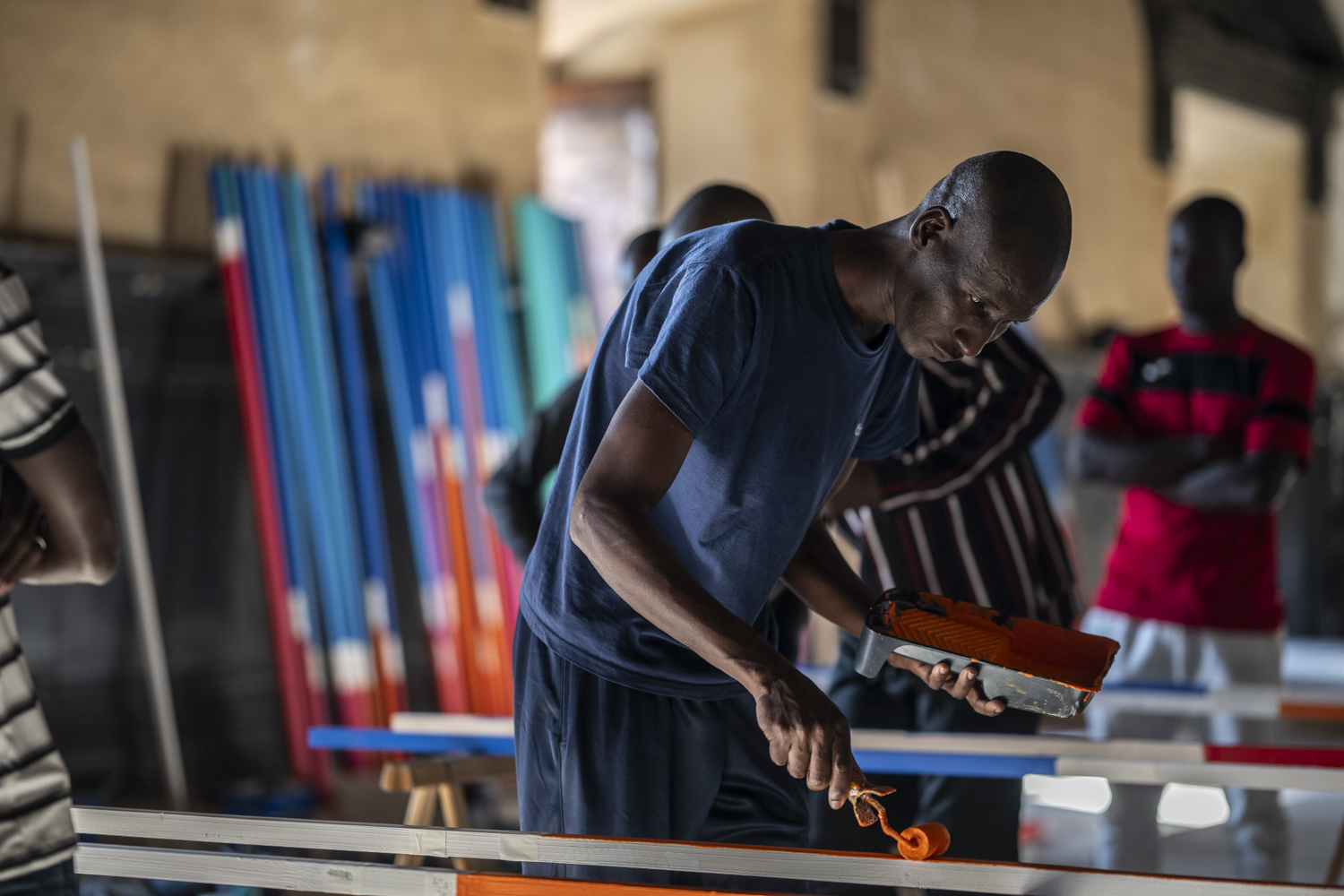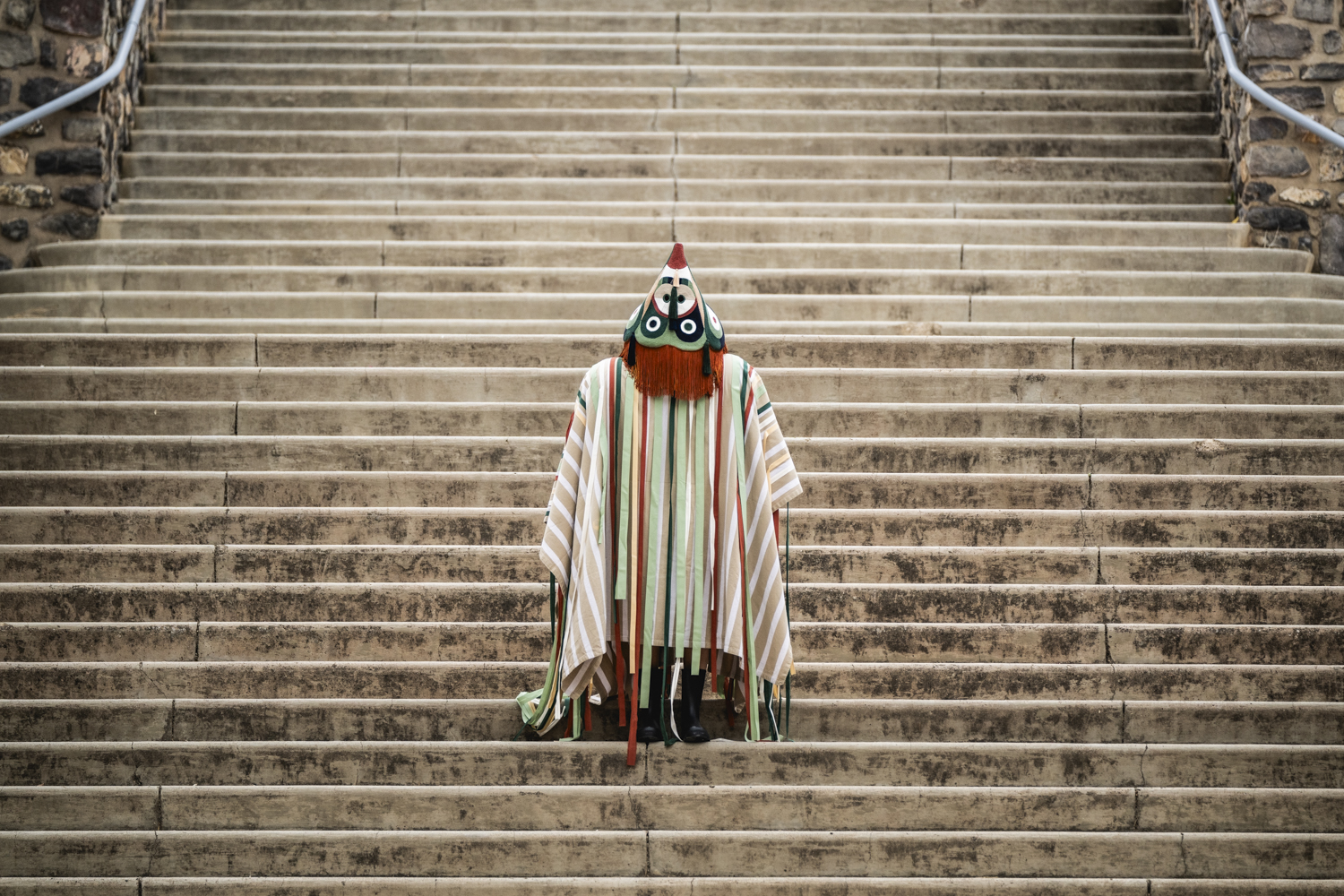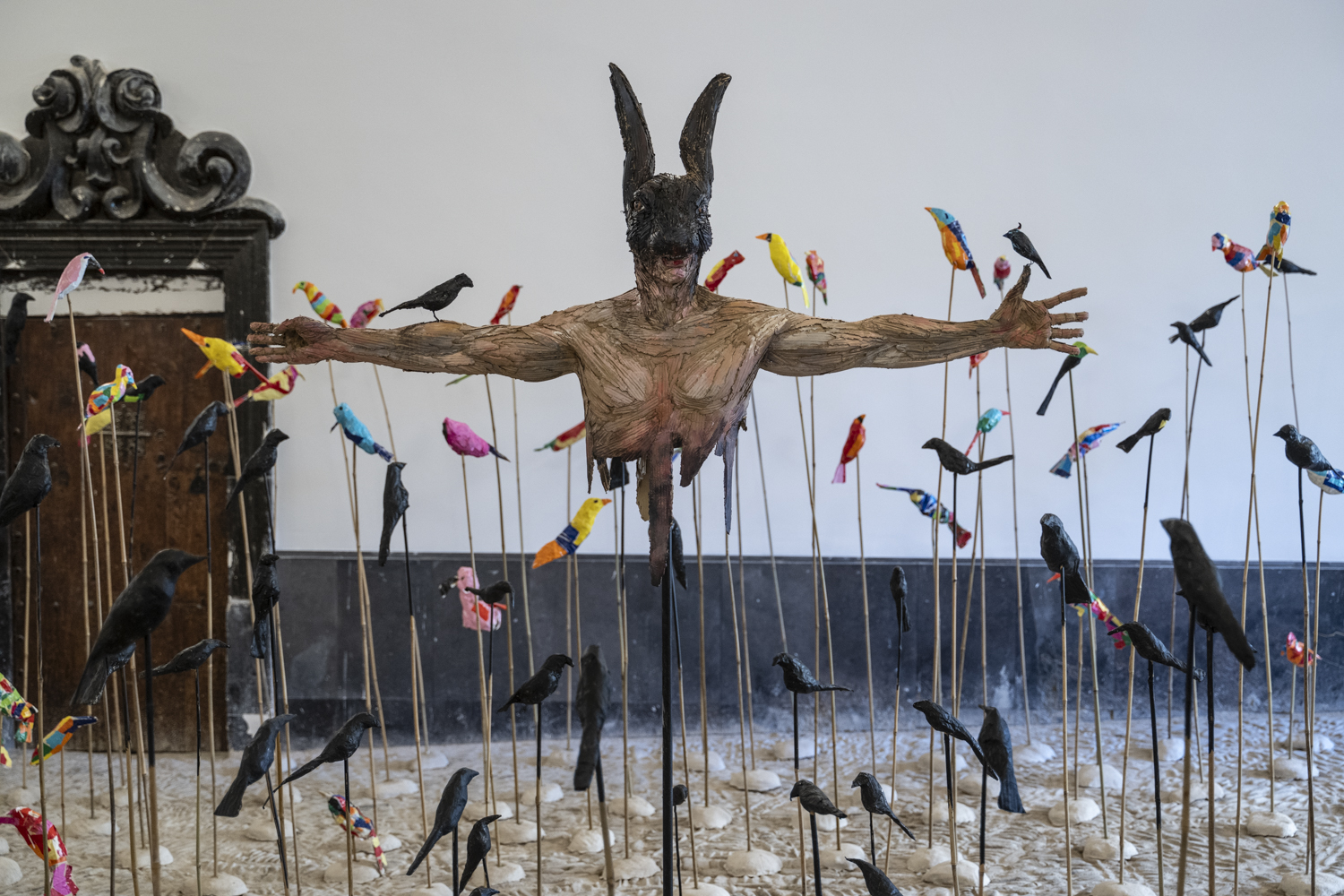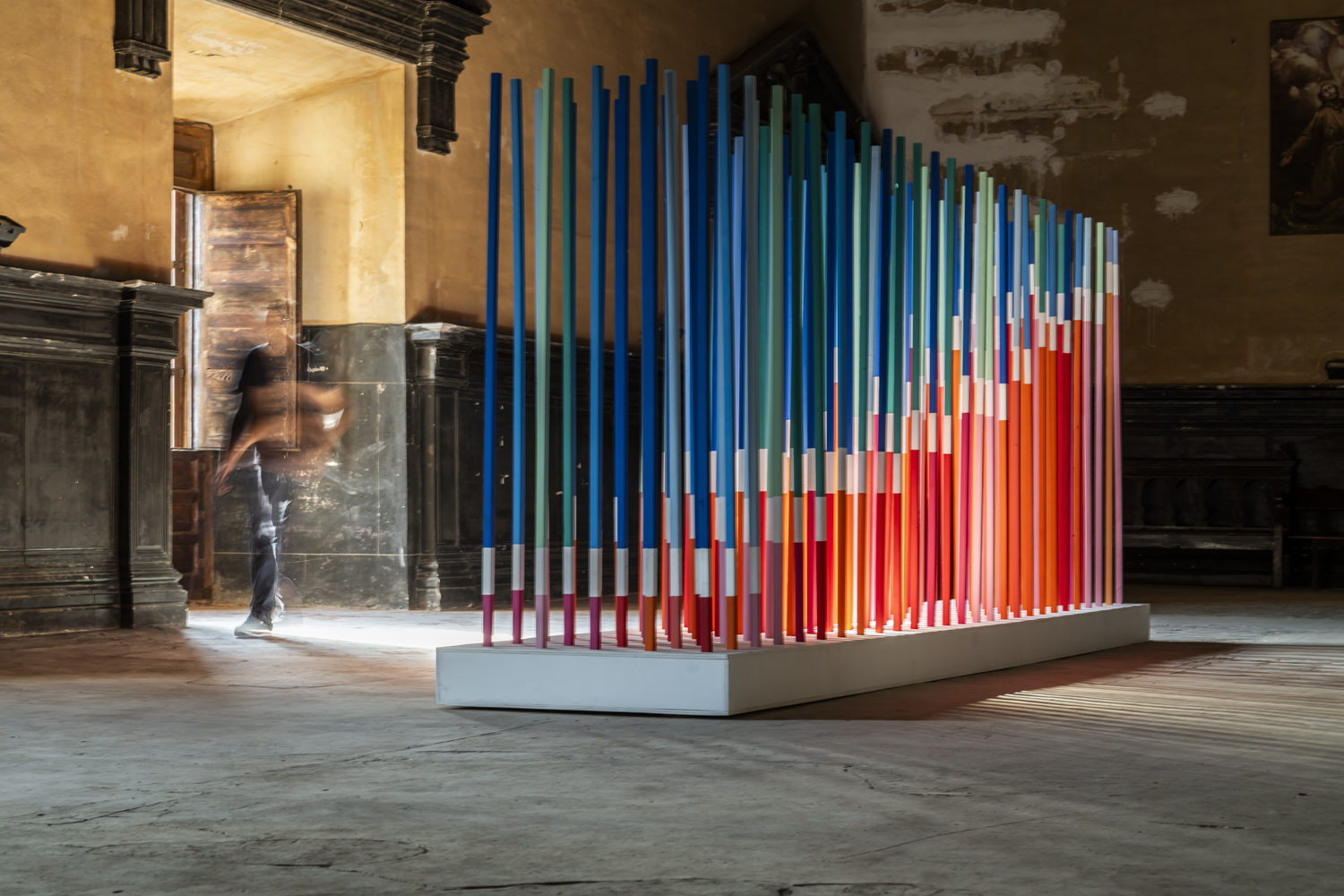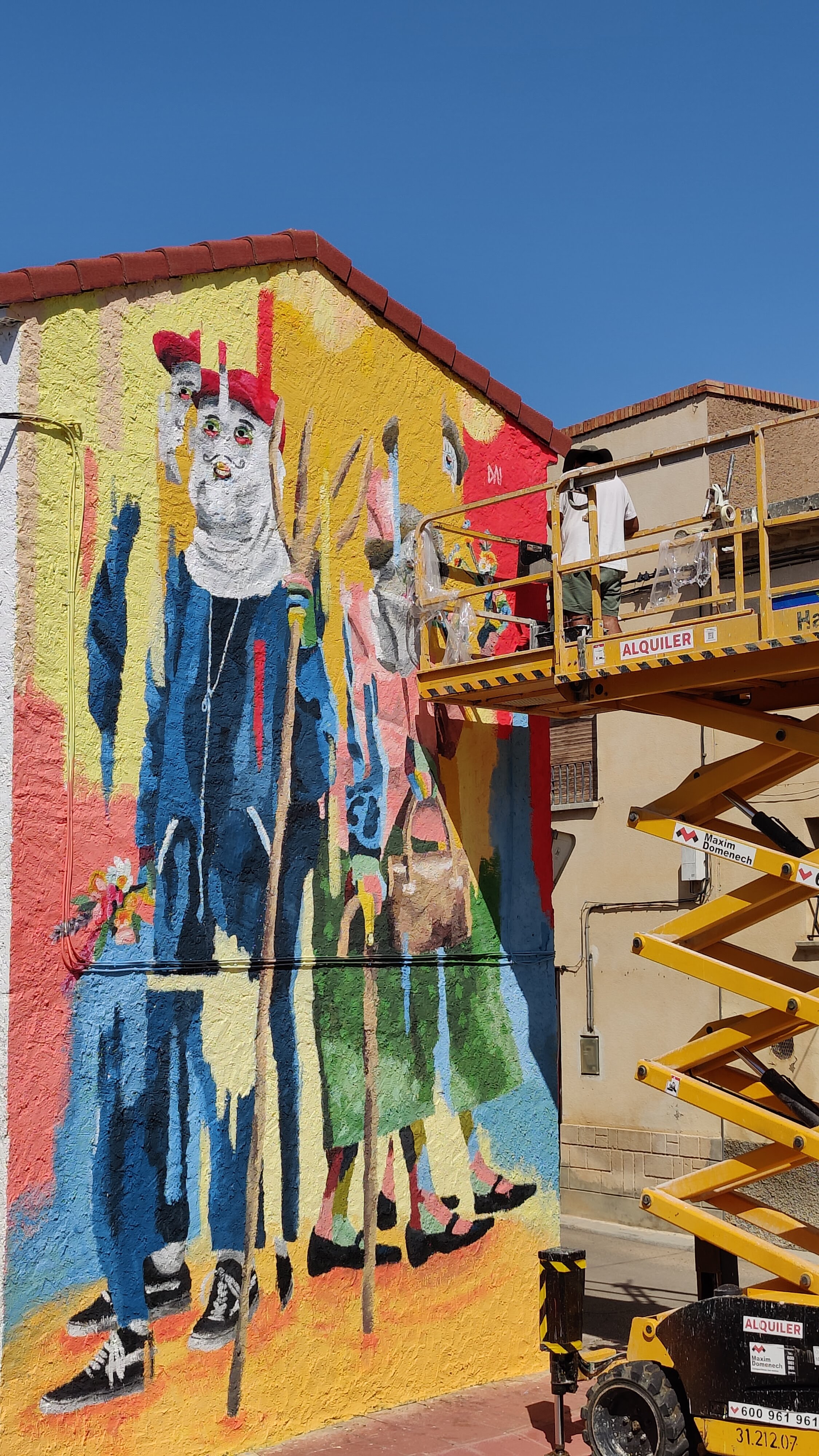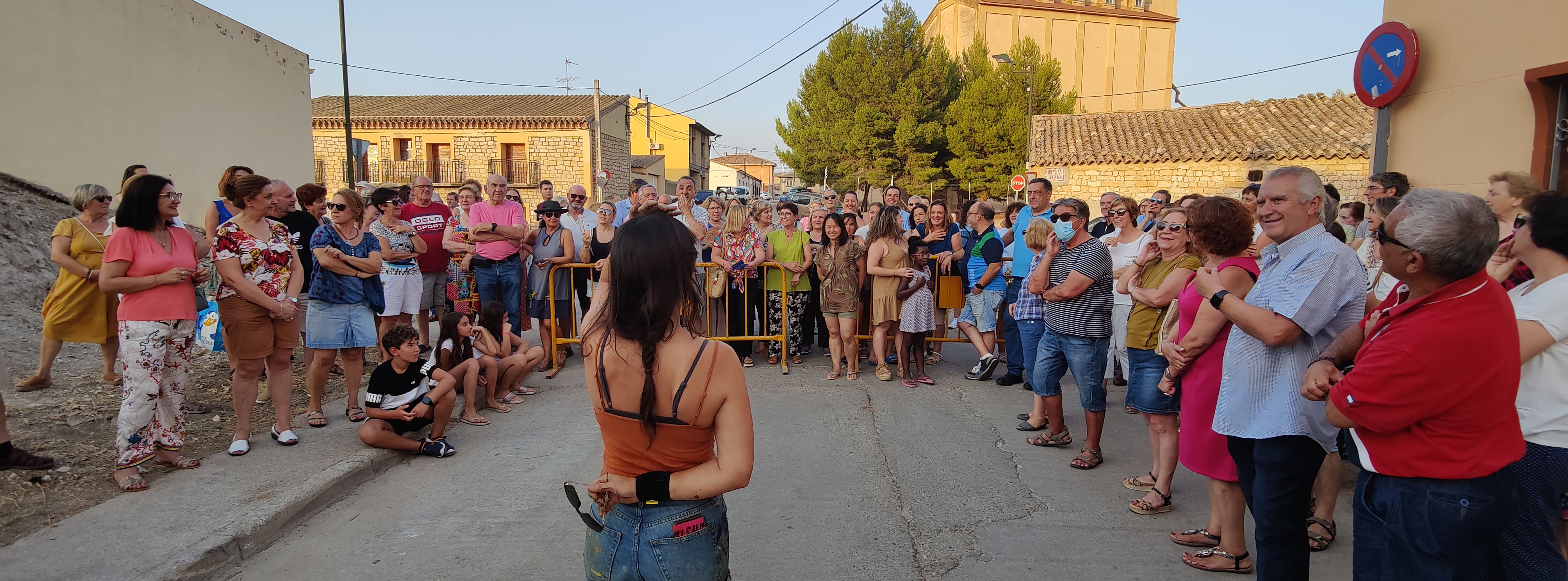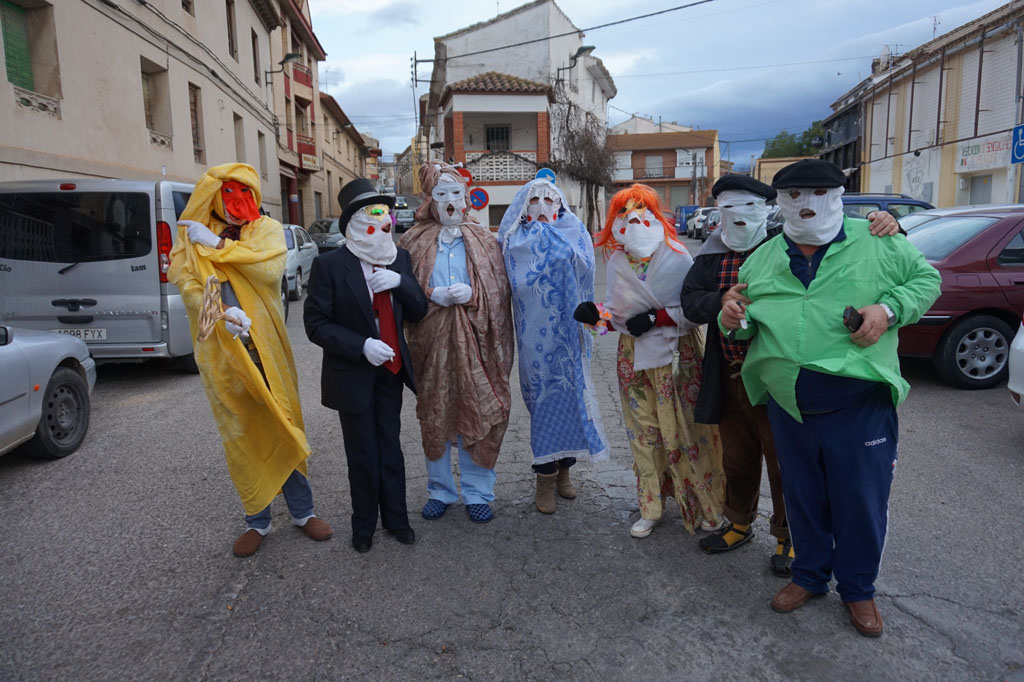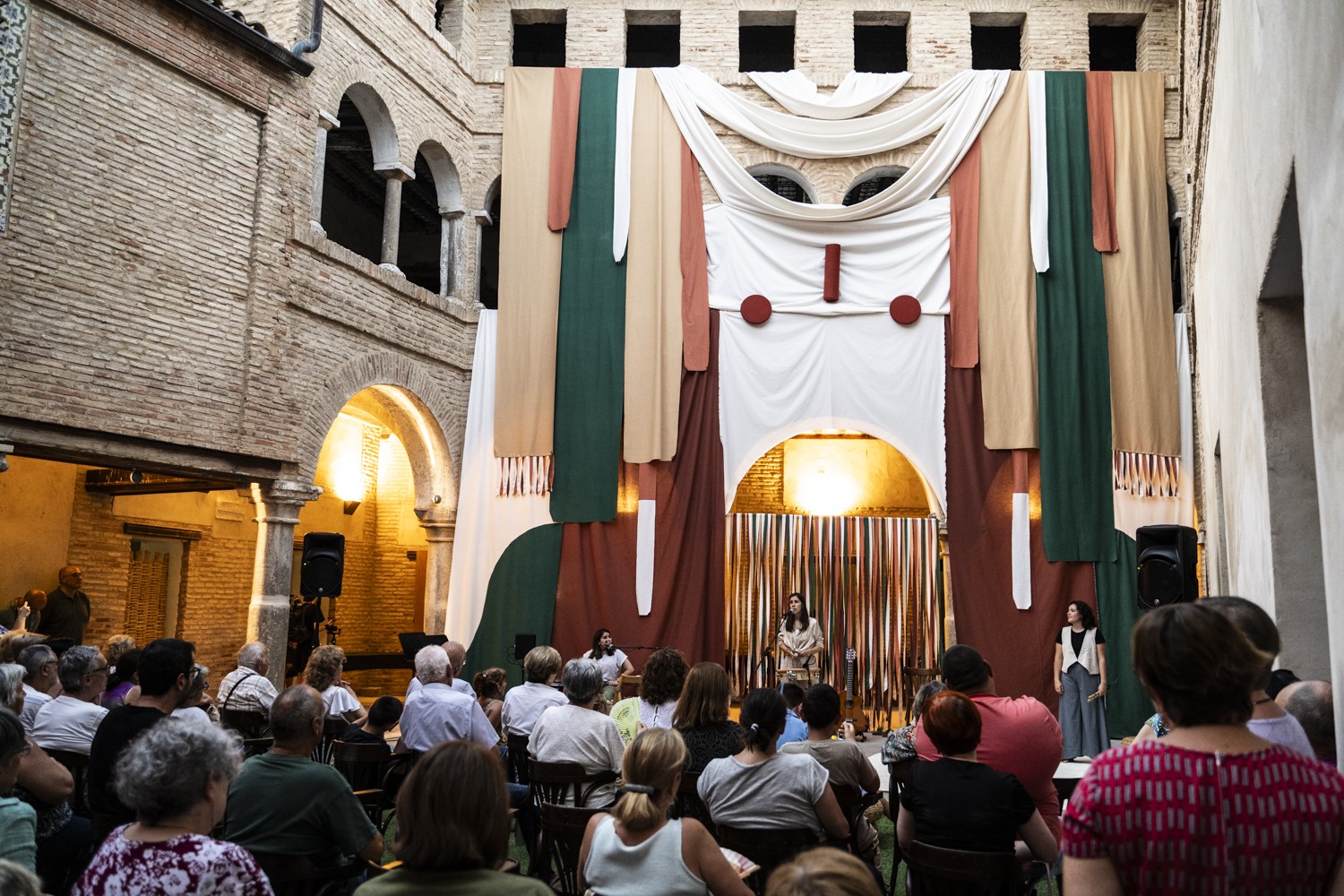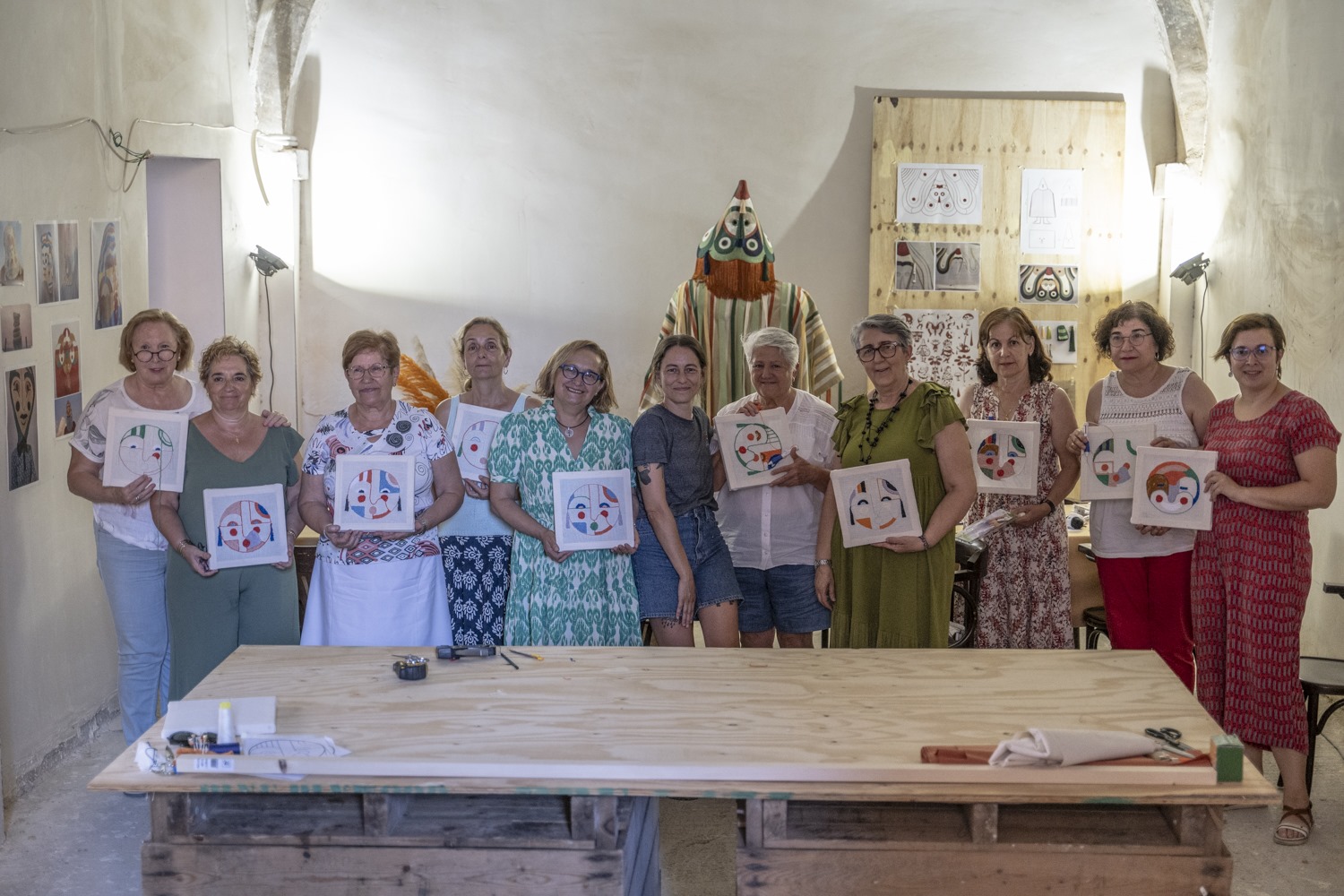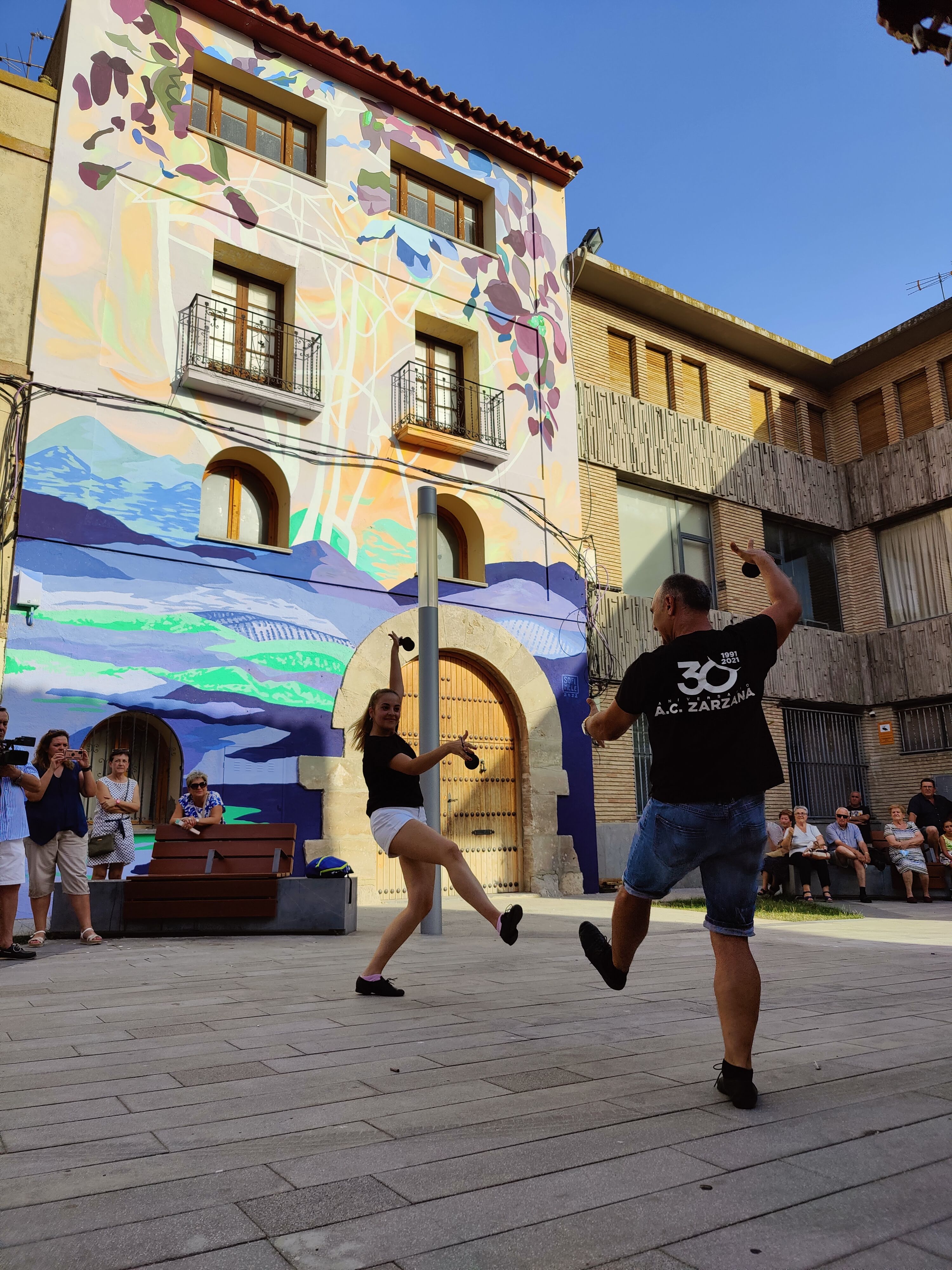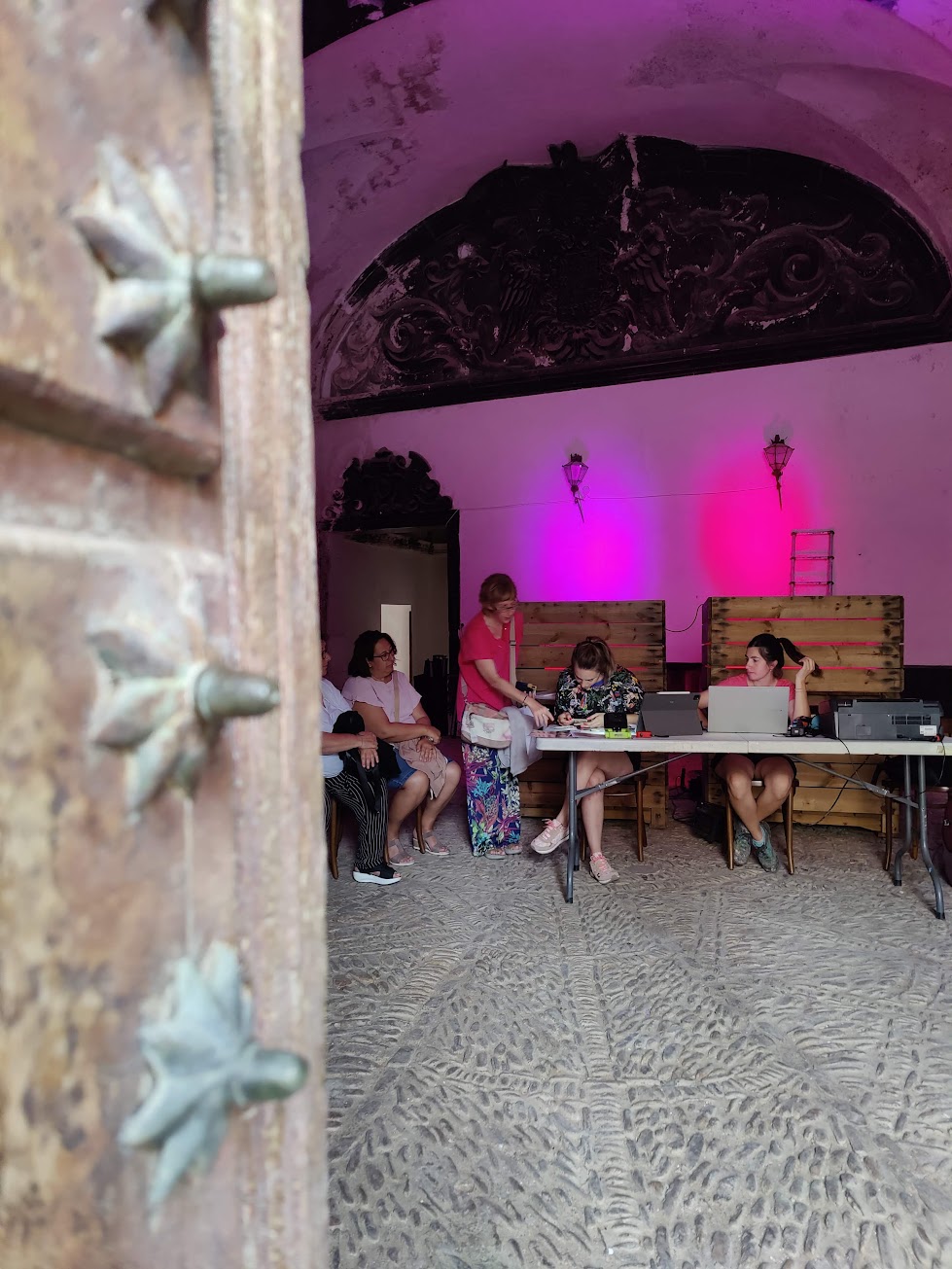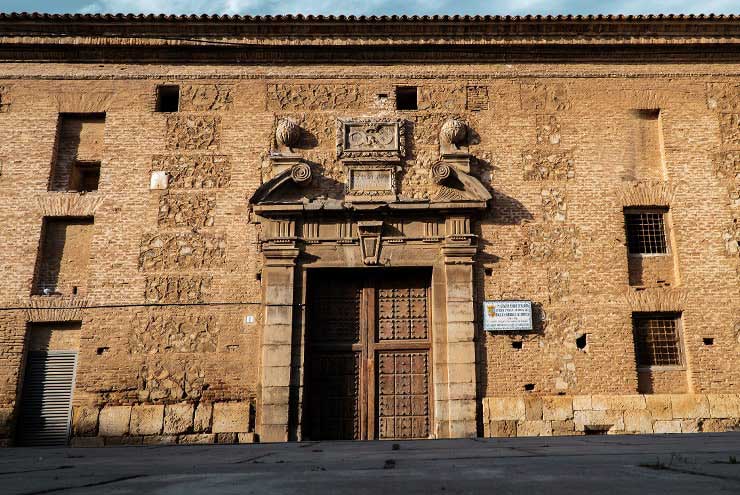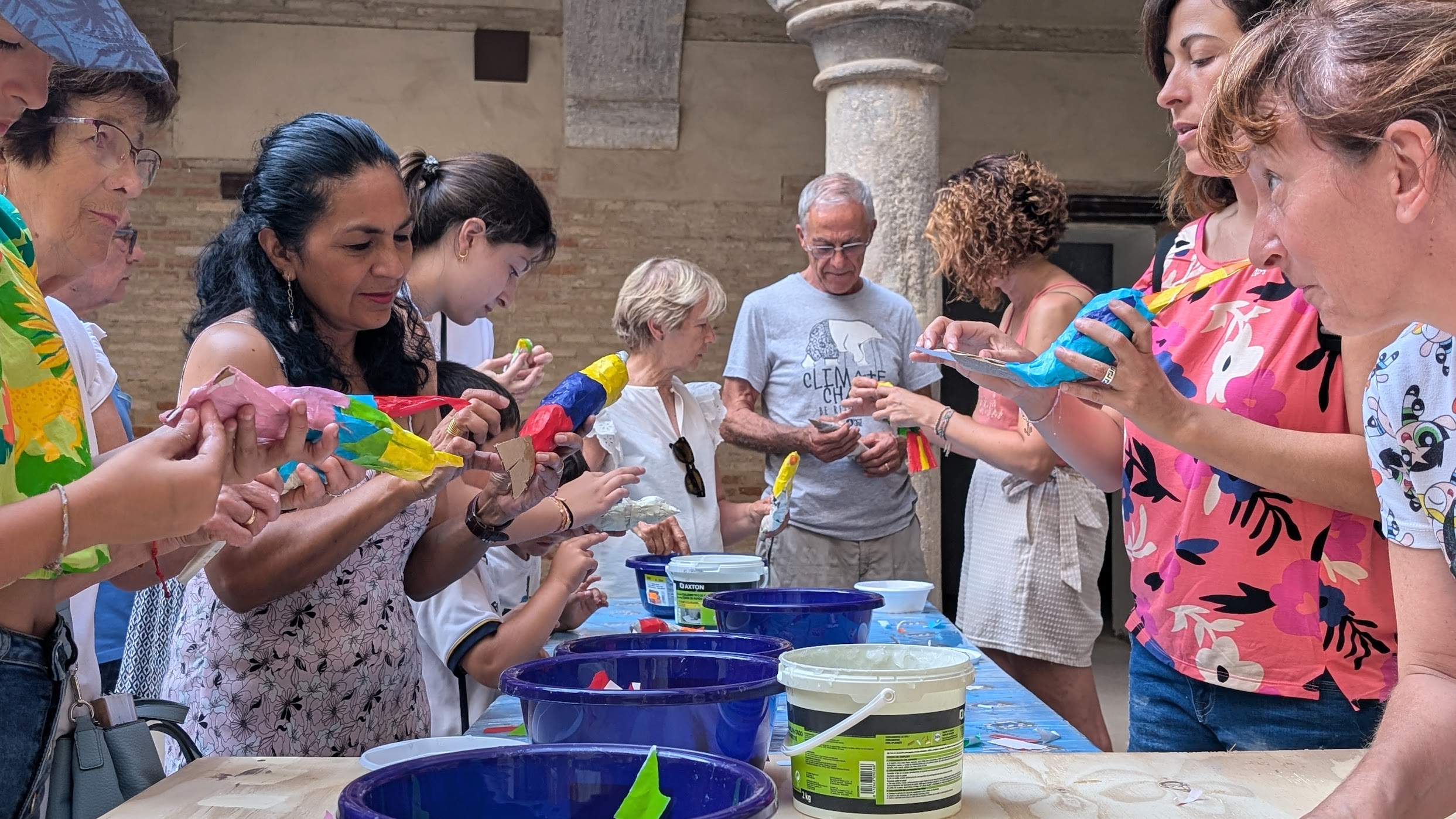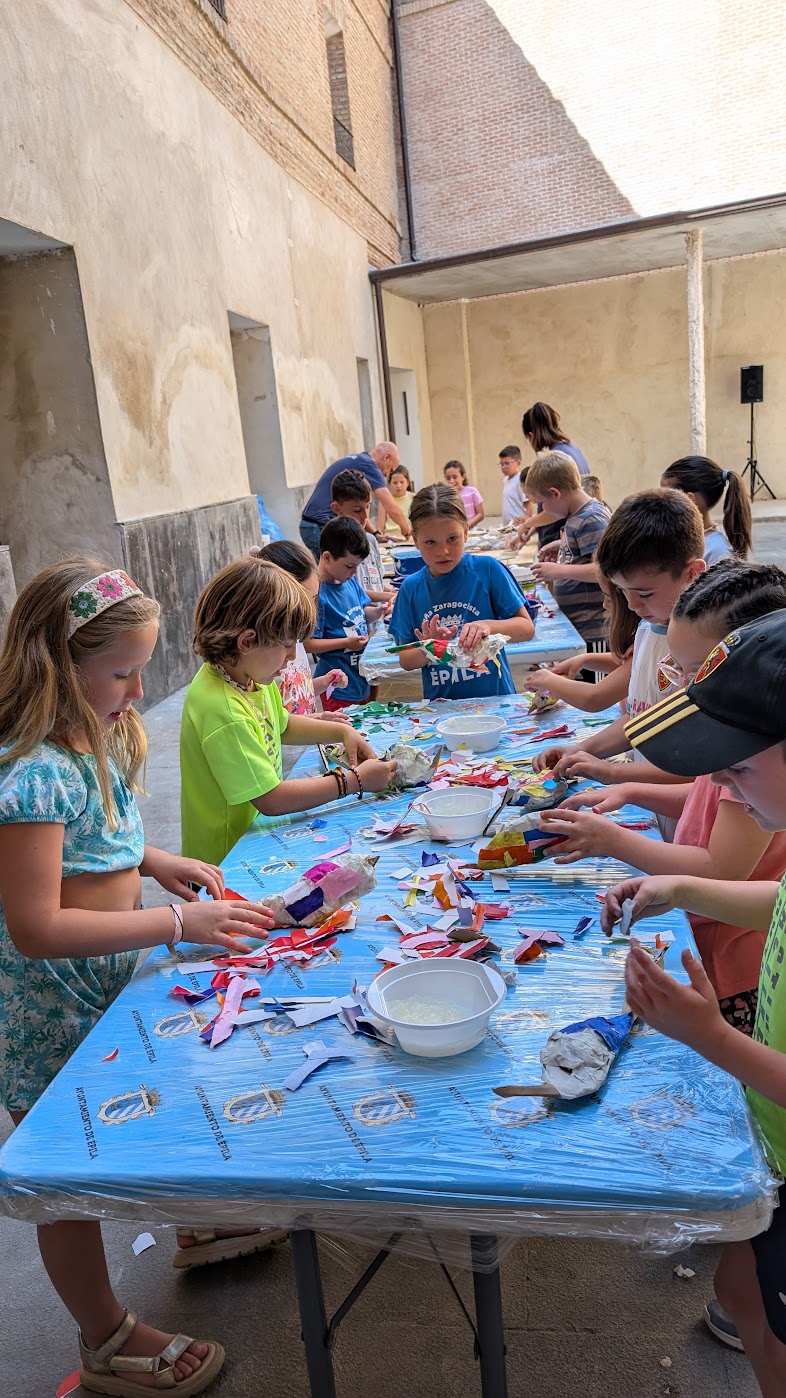Regaining a sense of belonging
Asalto in Epila
{Empty}
"Asalto en Épila" is an artistic and social intervention project in the town, inspired by its history, traditions, community achievements, future challenges, and other identity-related aspects. It aims to foster social cohesion through direct participation and engagement with various artistic proposals, revisiting local identity and strengthening the sense of belonging with a cross-cutting, intergenerational, and participatory approach.
Spain
Local
Épila (Zaragoza), Spain.
Mainly rural
It refers to other types of transformations (soft investment)
Yes
2024-07-21
No
No
No
As a representative of an organisation, in partnership with other organisations
Asalto en Épila is an artistic and social intervention project that has been taking place for 3 years in the town of Épila. The project connects the history of this rural place, its traditions, community achievements, future challenges, and different aspects of identity with artists from various disciplines to create artistic interventions and experiences. The main objectives are to imagine a different city and foster the cohesion of the population in a time of great socio-demographic change due to the arrival of large food industry companies and data centers that will bring significant change to this rural town, which has traditionally relied on agriculture.
The project began by creating artistic murals inspired by local history, landscape, and traditions in various locations throughout the town. The 2nd edition focused on the town’s Carnival, a highly characteristic, identity-defining, and popular event. This was achieved through mural interventions and the activation of an old and unused palace as a gathering space for other artistic interventions, popular meetings, workshops, etc. In a 3th edition, the project has found its true purpose through the direct participation of different groups of residents with the involved artists. As a result, the artistic creations now incorporate citizen engagement in their conception, taking place in a unique and unused heritage space—the former Palacio del Conde de Aranda, which once belonged to the Duchess of Alba but is now owned by the municipality.
The most significant outcome is the high level of direct participation in the program of actions and activities since the first edition, where the audience was less dynamic than in the last two editions, in which the neighbors have moved from being mere observers to becoming part of the artistic and creative processes.
The project began by creating artistic murals inspired by local history, landscape, and traditions in various locations throughout the town. The 2nd edition focused on the town’s Carnival, a highly characteristic, identity-defining, and popular event. This was achieved through mural interventions and the activation of an old and unused palace as a gathering space for other artistic interventions, popular meetings, workshops, etc. In a 3th edition, the project has found its true purpose through the direct participation of different groups of residents with the involved artists. As a result, the artistic creations now incorporate citizen engagement in their conception, taking place in a unique and unused heritage space—the former Palacio del Conde de Aranda, which once belonged to the Duchess of Alba but is now owned by the municipality.
The most significant outcome is the high level of direct participation in the program of actions and activities since the first edition, where the audience was less dynamic than in the last two editions, in which the neighbors have moved from being mere observers to becoming part of the artistic and creative processes.
public art
collaborative creative process
local participation
urban space enhacement
cultural and historic heritage review
The project strengthens social cohesion by actively involving the population in a unique artistic and cultural process, specifically designed for the community.
Community participation: Local residents are not just spectators but active contributors to the project, fostering a sense of belonging-
Involvement of key local figures: Throughout the process, important members of the community have been identified and integrated, contributing to both the organizational and artistic aspects, thus strengthening local collaboration networks.
Promotion of cultural identity: The revitalization of historical and urban spaces through art reinforces cultural heritage and collective memory, turning art into a driver of social transformation.
The project applies sustainability principles through responsible resource use and minimal ecological impact:
Use of local materials: Priority is given to locally sourced materials, reducing the carbon footprint associated with transportation.
Reuse and upcycling: Materials from previous editions are repurposed, and objects recovered from the natural environment or donated by local businesses are incorporated, promoting a circular economy.
Low-impact urban regeneration: The intervention in urban spaces is conducted respectfully, without causing permanent alterations to the environment.
The impact of the project extends beyond art, generating economic and heritage benefits for the community:
Revitalization of local commerce and services: The regeneration of urban spaces and unused historical buildings stimulates commercial and tourism activity, attracting visitors and boosting the local economy.
Reuse of the Palacio del Conde de Aranda: The restoration of this historic building for cultural purposes demonstrates that rehabilitating and repurposing existing heritage is a more sustainable and cost-effective alternative to constructin
Community participation: Local residents are not just spectators but active contributors to the project, fostering a sense of belonging-
Involvement of key local figures: Throughout the process, important members of the community have been identified and integrated, contributing to both the organizational and artistic aspects, thus strengthening local collaboration networks.
Promotion of cultural identity: The revitalization of historical and urban spaces through art reinforces cultural heritage and collective memory, turning art into a driver of social transformation.
The project applies sustainability principles through responsible resource use and minimal ecological impact:
Use of local materials: Priority is given to locally sourced materials, reducing the carbon footprint associated with transportation.
Reuse and upcycling: Materials from previous editions are repurposed, and objects recovered from the natural environment or donated by local businesses are incorporated, promoting a circular economy.
Low-impact urban regeneration: The intervention in urban spaces is conducted respectfully, without causing permanent alterations to the environment.
The impact of the project extends beyond art, generating economic and heritage benefits for the community:
Revitalization of local commerce and services: The regeneration of urban spaces and unused historical buildings stimulates commercial and tourism activity, attracting visitors and boosting the local economy.
Reuse of the Palacio del Conde de Aranda: The restoration of this historic building for cultural purposes demonstrates that rehabilitating and repurposing existing heritage is a more sustainable and cost-effective alternative to constructin
Asalto in Epila is a project conceived as an artistic intervention that transforms the urban and social environment through art and culture. Its key objectives focus on the revaluation of public spaces, accessibility to art as a tool for participation, and the creation of an environment that encourages the appropriation of common spaces.
The beauty of the project can be seen from multiple perspectives. Of course, the final results—the artworks created—possess the intrinsic beauty of high-quality artists with a clear and well-defined creative concept. However, the true beauty of this project lies in the participation of the community alongside the artists through prior co-creation processes, elevating the artistic experience to another level. It is the beauty of accessibility to artistic creation as a community, the beauty of dialogue among equals, and the exchange of knowledge and experiences. It is the beauty of demonstrating that together, we are capable of improving our lives, those of our neighbors, and our town.
Beauty also resides in the exemplary collaboration between artists and residents, in their collective effort, and in their ability to make joint decisions. In a town with a high number of residents from different countries, artistic creation and visible creativity in shared spaces foster unexpected encounters and personal connections that might not happen otherwise. Additionally, it allows those involved to reveal their most hidden talents in community.
The beauty of the project can be seen from multiple perspectives. Of course, the final results—the artworks created—possess the intrinsic beauty of high-quality artists with a clear and well-defined creative concept. However, the true beauty of this project lies in the participation of the community alongside the artists through prior co-creation processes, elevating the artistic experience to another level. It is the beauty of accessibility to artistic creation as a community, the beauty of dialogue among equals, and the exchange of knowledge and experiences. It is the beauty of demonstrating that together, we are capable of improving our lives, those of our neighbors, and our town.
Beauty also resides in the exemplary collaboration between artists and residents, in their collective effort, and in their ability to make joint decisions. In a town with a high number of residents from different countries, artistic creation and visible creativity in shared spaces foster unexpected encounters and personal connections that might not happen otherwise. Additionally, it allows those involved to reveal their most hidden talents in community.
The project is designed to connect with different population profiles, which is reviewed and updated each year based on feedback from participants and local stakeholders (both residents and municipal representatives), as well as social changes, such as the arrival of new inhabitants due to the industrialization process in the region and other migratory circumstances.
Thanks to this assessment, the project's artistic coordination team (four people) proposes different artistic profiles that generate a series of artistic proposals and creative processes tailored to various population groups—youth, seniors, migrants, etc.—ensuring that their participation, facilitated by stakeholders and other local agents, is organic, direct, and fully engaging. When people are recognized and invited to be part of this collective transformation process through their interests, skills, or specific knowledge, they become active participants and drivers of the program rather than mere spectators.
Dialogue and preliminary work with the artists are essential to identify the most suitable profiles, ensuring that their work and proposals will connect with the Epila´s neighbors.
Additionally, the project aligns with design for all principles, ensuring that artistic works and transformed spaces are functional and meaningful for the entire community. By integrating diverse voices and perspectives into the creative process, the project has not only beautified the urban environment but also reflected collective identity and fostered social inclusion.
Thanks to this assessment, the project's artistic coordination team (four people) proposes different artistic profiles that generate a series of artistic proposals and creative processes tailored to various population groups—youth, seniors, migrants, etc.—ensuring that their participation, facilitated by stakeholders and other local agents, is organic, direct, and fully engaging. When people are recognized and invited to be part of this collective transformation process through their interests, skills, or specific knowledge, they become active participants and drivers of the program rather than mere spectators.
Dialogue and preliminary work with the artists are essential to identify the most suitable profiles, ensuring that their work and proposals will connect with the Epila´s neighbors.
Additionally, the project aligns with design for all principles, ensuring that artistic works and transformed spaces are functional and meaningful for the entire community. By integrating diverse voices and perspectives into the creative process, the project has not only beautified the urban environment but also reflected collective identity and fostered social inclusion.
The creation and development of this project has successfully connected with the population of Épila because it review their territory, history and traditions through an artistic, participatory, and collective lens. It is an open and free project, with the emotional intelligence needed to identify the talent and skills of local people and groups to integrate them into transformative creative processes that generate a positive visual impact, activate collective spaces, and create a unique project, personal and accessible to all audiences.
The project has also been used as a resource by certain entities in the town, such as the high school, which has carried out several projects with students around the created artworks. It has also led to the creation of a shared space designed and built by the students and creatives involved in Asalto in Épila.
Migration present in the territory is also part of the project, thanks to the participation of different facilitators who build bridges between different cultures and nationalities which are part of the local society, either constantly or temporarily.
A small but significant indicator of what the project achieves is its ability to generate a safe space for some neighbors with certain hidden creative or artistic skills to share them with the community when they hadn't done so previously due to not finding a favorable context for affective and caring relationships.
The project has also been used as a resource by certain entities in the town, such as the high school, which has carried out several projects with students around the created artworks. It has also led to the creation of a shared space designed and built by the students and creatives involved in Asalto in Épila.
Migration present in the territory is also part of the project, thanks to the participation of different facilitators who build bridges between different cultures and nationalities which are part of the local society, either constantly or temporarily.
A small but significant indicator of what the project achieves is its ability to generate a safe space for some neighbors with certain hidden creative or artistic skills to share them with the community when they hadn't done so previously due to not finding a favorable context for affective and caring relationships.
Asalto en Épila is a project supported by the City Council of Épila. This support is essential to sustain the initiative and evolve it in the way we have been explaining to address the challenges described. In addition to this municipal support, the project has been able to attract various key players present in the local and regional society, such as educational centers, the group of elderly people, the housewives' association, youth groups, local artists, the municipal music band, or folklore associations.
Recently, we have obtained some economic support from the Department of Culture of the Government of Aragón, which helps the project grow, and we want it to evolve into a network of other projects at the national and European level. This will allow us to share artistic practices and experiences that address the changes faced by medium-sized rural areas and those in full industrial development.
Recently, we have obtained some economic support from the Department of Culture of the Government of Aragón, which helps the project grow, and we want it to evolve into a network of other projects at the national and European level. This will allow us to share artistic practices and experiences that address the changes faced by medium-sized rural areas and those in full industrial development.
Our approach to the project is rooted in the knowledge that the core team has acquired through nearly twenty years of creative experience in the fields of urban art, public art, and its social impact in various urban and rural contexts. Additionally, the presence of designers on the team allows us to apply more transversal approaches to the project, designing content, proposing innovative implementation methods, and considering all possible user profiles during the design, execution, and implementation phases.
Other professional profiles contribute valuable knowledge to the project. On the one hand, the municipal team—composed of technicians and councilors from different departments—provides a strong local perspective, helping to connect with various community groups and explore new possibilities. The teaching staff from Épila’s school and high school have also participated through different initiatives, involving young people in decision-making and the execution of projects linked to Asalto en Épila.
Another key aspect is the convergence of different artistic disciplines within the project, offering various channels of interaction with the community through diverse perspectives, techniques, and artistic proposals. The previous experience of involved artists in community-driven projects is essential in shaping an inclusive, participatory program aligned with the project's objectives.
Finally, the contribution of neighbors is fundamental. Whether through oral histories, photographs, or sharing Épila’s folklore, their input is key to identifying the best lines of work and selecting the participating artists who propose and facilitate processes in which the community becomes the true protagonist. The results is a strong and transformative sense of community empowerment.
Other professional profiles contribute valuable knowledge to the project. On the one hand, the municipal team—composed of technicians and councilors from different departments—provides a strong local perspective, helping to connect with various community groups and explore new possibilities. The teaching staff from Épila’s school and high school have also participated through different initiatives, involving young people in decision-making and the execution of projects linked to Asalto en Épila.
Another key aspect is the convergence of different artistic disciplines within the project, offering various channels of interaction with the community through diverse perspectives, techniques, and artistic proposals. The previous experience of involved artists in community-driven projects is essential in shaping an inclusive, participatory program aligned with the project's objectives.
Finally, the contribution of neighbors is fundamental. Whether through oral histories, photographs, or sharing Épila’s folklore, their input is key to identifying the best lines of work and selecting the participating artists who propose and facilitate processes in which the community becomes the true protagonist. The results is a strong and transformative sense of community empowerment.
Asalto en Épila is an innovative project that understands artistic creation in relation to communities as a shared space that fosters safe environments for building relationships among people in a rural context undergoing significant socio-cultural and demographic change.
Creativity, the disruption of the everyday, and the opportunity to create and be a fundamental part of a project linked to the local identity become powerful tools for transformation and humanization in a society that at times feels disconnected and disengaged.
Compared to mainstream projects, Asalto in Epila promotes a co-creation process where local inhabitants are not merely spectators but active agents in the development of the artworks. This involvement strengthens their sense of belonging and creates an emotional connection through art.
The methodology we employ and the almost handcrafted configuration of each edition—bringing together key elements to ensure everything works in harmony—allow artistic interventions to engage in dialogue with the place, becoming an extension of the town’s identity.
Finally, another innovative aspect that defines this project is the disruptive use of public space and the Palacio del Conde de Aranda. The project strives to transform vacant spaces into places for the community, filling them with activity and collective processes that reinforce the sense of belonging and highlight the transformative power of an initiative deeply rooted in, and collectively designed, specifically for Épila.
Creativity, the disruption of the everyday, and the opportunity to create and be a fundamental part of a project linked to the local identity become powerful tools for transformation and humanization in a society that at times feels disconnected and disengaged.
Compared to mainstream projects, Asalto in Epila promotes a co-creation process where local inhabitants are not merely spectators but active agents in the development of the artworks. This involvement strengthens their sense of belonging and creates an emotional connection through art.
The methodology we employ and the almost handcrafted configuration of each edition—bringing together key elements to ensure everything works in harmony—allow artistic interventions to engage in dialogue with the place, becoming an extension of the town’s identity.
Finally, another innovative aspect that defines this project is the disruptive use of public space and the Palacio del Conde de Aranda. The project strives to transform vacant spaces into places for the community, filling them with activity and collective processes that reinforce the sense of belonging and highlight the transformative power of an initiative deeply rooted in, and collectively designed, specifically for Épila.
The evolving nature of this project requires a flexible, adaptable, and responsive methodology to face this project, the updating of challenges or needs, the potential for participation from certain population profiles over others, or even the selection of specific themes. Constant and direct contact with the community is very important and allows us to continue increasing our understanding of the context, gathering written, photographic, and oral information that is crucial in order to design and propose actions that truly connect with the community. Each year, a preliminary diagnosis is conducted or updated to decide which topics can be addressed and which population profile will be targeted.Thus, an artistic search or call is opened to work within the defined guidelines, including in their proposal the collective conception of the work or project. Meanwhile, a series of complementary activities are designed to encourage the participation and engagement of other groups or individuals who, for some reason, have not connected with the project previously. For this design, we take into account a broad network of local collaborators: schools, health centers, sports or cultural organizations, merchant associations, etc. The way this phase of the methodology is developed is also handcrafted and involves personalized visits and meetings focused on creating safe spaces to identify the potential of any individual or group to be part of the project. With the working line defined, the technical production phase is activated to make the realization of the projects possible by obtaining and facilitating all necessary infrastructure, content organization, and external communication. The realization of a project of this nature is exposed to multiple incidents or situations that may arise in public spaces or in relation to the people involved, so the flexibility of the methodology and the team's expertise are essential to adapt to the changing circumstances.
The overall approach of the project can be replicated in other cities and towns both globally and partially. The formula is simple: use the talent and perspective of artists and creatives to carry out a series of high artistic value proposals that involve the participation of the local community, drawing inspiration from it to create a strong and effective connection.
Having said this, the technical team is key to facilitate the process of connecting with local entities and the society. A team with experience, skills, and specific knowledge will be able to facilitate this experience and ensure its transfer to new territories. For this purpose, a methodology manual and best practices guide would be very valuable and useful.
Other aspects that can be replicated:
1. The evolving design of the project year after year, which aims to capture the attention of the community (1st year) and continue involving them (next editios) actively in the design and content of a transformative and identity-building project.
2. The methodological approach shared with the artists to develop proposals in which community participation is essential.
3. The complementary activities carried out, such as specific workshops, which connect the community with their context in an innovative, active, and participatory manner.
4. The use of unused architectural spaces to give them new meaning with the direct participation of the community, as a collective exercise in appropriation and recovery of public or privately-owned heritage (for public use).
Having said this, the technical team is key to facilitate the process of connecting with local entities and the society. A team with experience, skills, and specific knowledge will be able to facilitate this experience and ensure its transfer to new territories. For this purpose, a methodology manual and best practices guide would be very valuable and useful.
Other aspects that can be replicated:
1. The evolving design of the project year after year, which aims to capture the attention of the community (1st year) and continue involving them (next editios) actively in the design and content of a transformative and identity-building project.
2. The methodological approach shared with the artists to develop proposals in which community participation is essential.
3. The complementary activities carried out, such as specific workshops, which connect the community with their context in an innovative, active, and participatory manner.
4. The use of unused architectural spaces to give them new meaning with the direct participation of the community, as a collective exercise in appropriation and recovery of public or privately-owned heritage (for public use).
Society is becoming increasingly stratified and partitioned, and problems or challenges are rarely faced up collectively. Global pandemics, wars, migratory movements, aggressive economic models, human and technological inequalities, IA, etc. The globalization of lifestyles and social alienation is a challenge that must be tackled from different perspectives, fostering critical thinking and creating spaces for dialogue, experimentation and connection. On the other hand, the current urban and consumption model is creating large-scale logistics, data center and food processing hubs, designed to meet the needs of society. This may seem attractive in terms of job creation and has a clear and significant impact on the demographic growth of these regions. However, it also presents a series of challenges that society and public administration must deal with. In this context, our project becomes particularly necessary. The arrival of new residents can transform the social and cultural structure of the village. Asalto en Épila is a tool for integrating these new neighbors, fostering dialogue between different generations and backgrounds while helping to preserve the local identity, even as new influences are incorporated. Active participation in artistic creation allows both long-time residents and newcomers to contribute and take ownership of the shared space. A participatory project promotes cooperation, the exchange of experiences, and collective creation, strengthening the social context and building a more inclusive and united community. The artistic interventions that emerge from this process serve as physical and emotional meeting points. Not only do they help manage demographic change positively, but they also facilitate integration, mutual understanding, and the creation of a more cohesive, resilient, and creative environment. This is essential for the locality and the region to face future challenges with a common identity, a sense of belonging, and a shared vision.
The highest recognition achieved so far is confirm the deep connection between the project and the community of Epila. The project has successfully integrated into the population, empowering residents to become active participants in artistic interventions and processes. These efforts not only celebrate cultural heritage through art, but also work to strengthen neighborly bonds, foster new relationships, enhance the sense of belonging, and facilitate the transfer of knowledge and community values to newcomers settling in Epila.
It is also notable that the main Aragonese television made a documentary about part of this project, generating a great diffusion throughout the territory with a high impact on the audience> https://alacarta.aragontelevision.es/programas/festival-asalto/acto-ii-asalto%c2%b4-hacia-el-resto-de-aragon-19102023-2249
It is also notable that the main Aragonese television made a documentary about part of this project, generating a great diffusion throughout the territory with a high impact on the audience> https://alacarta.aragontelevision.es/programas/festival-asalto/acto-ii-asalto%c2%b4-hacia-el-resto-de-aragon-19102023-2249

